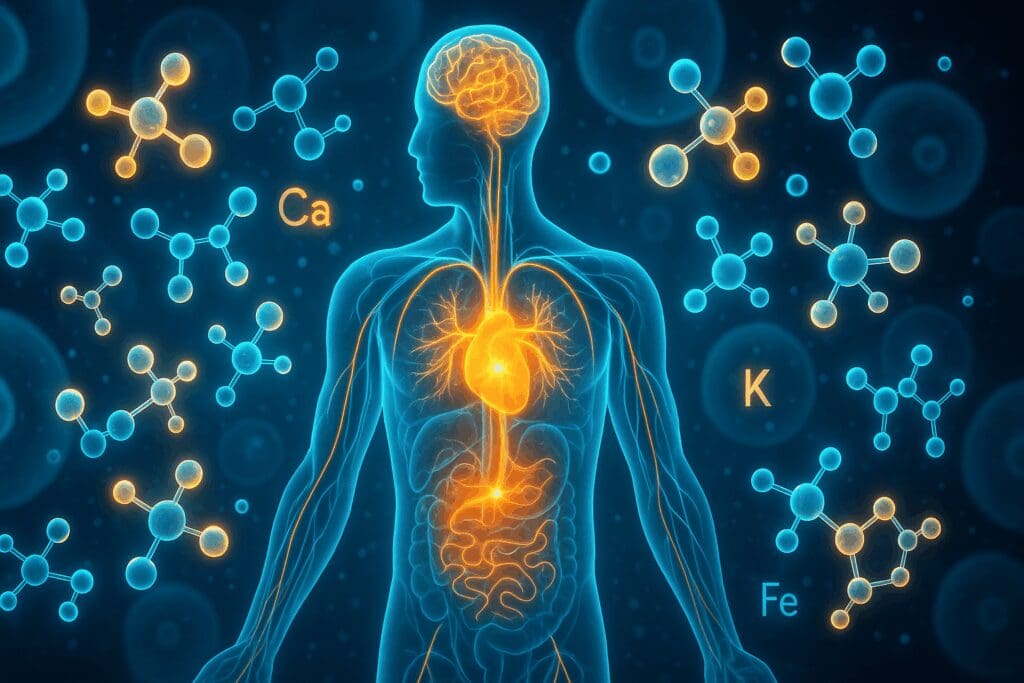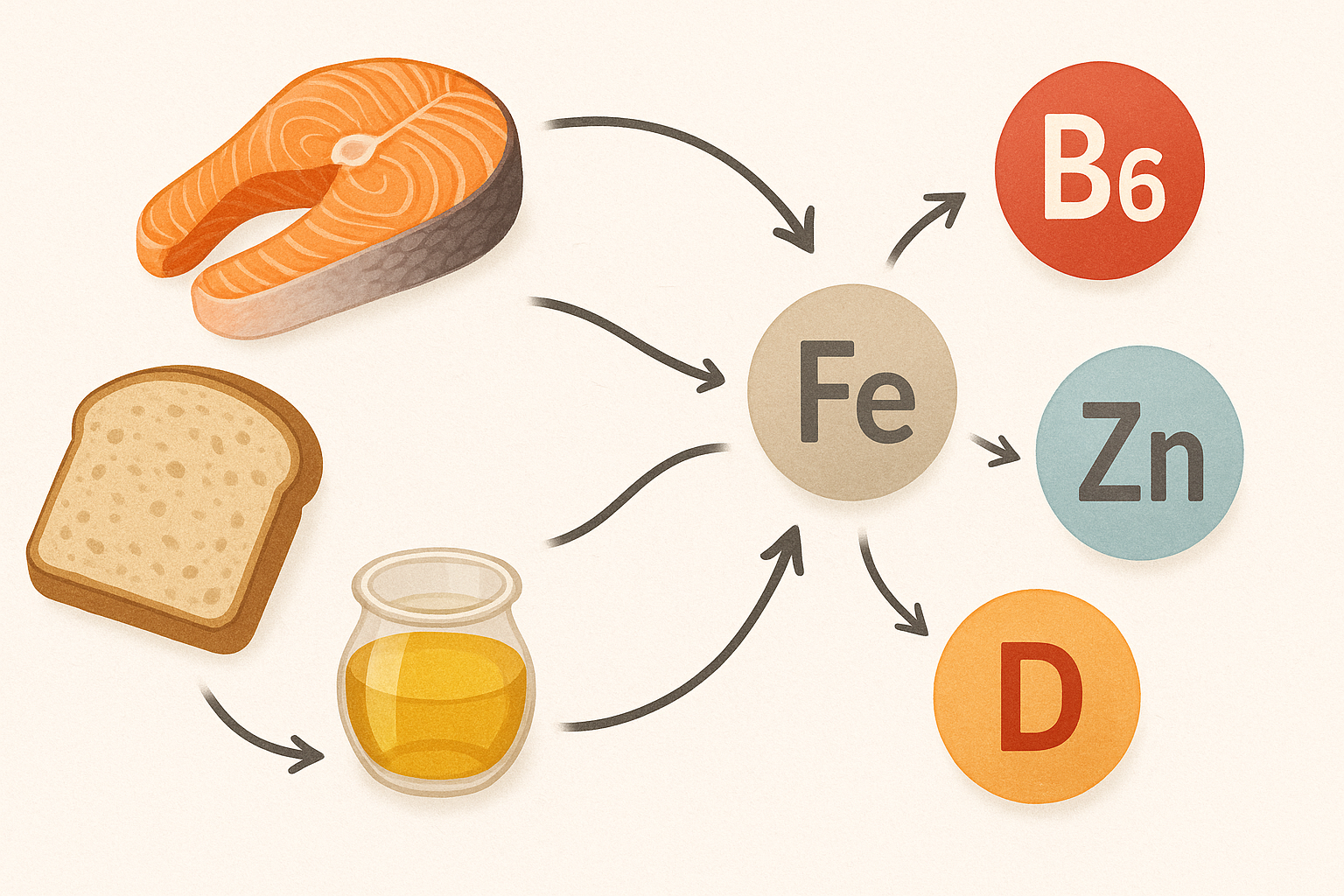Introduction: Exploring Nutrients as the Foundation of Human Health
In the modern world of health optimization, dietary choices are often framed in terms of popular superfoods, calorie tracking, or the newest diet trends. Yet the most fundamental question still eludes many: what are the 2 categories of nutrients, and why does this distinction hold such power over our health outcomes? Understanding this essential classification is the cornerstone of nutritional science and the bedrock of all dietary decisions, from the food pyramid to personalized eating plans. Nutrients are not arbitrary classifications—they are biochemical tools that serve highly specific and indispensable roles in the body. Recognizing these roles allows individuals to eat not only for satisfaction or tradition but for true physiological support.
There are thousands of foods to choose from, yet only two broad categories of nutrients form the basis of everything we consume: macronutrients and micronutrients. While the former delivers energy and structural components, the latter orchestrates chemical reactions and supports cellular communication. This dual framework explains why eating patterns that are either calorie-rich and nutrient-poor or nutrient-rich and calorie-deficient fail to meet holistic needs. By diving into these two nutrient categories in depth, we can bridge the gap between confusing dietary noise and actionable nutritional knowledge. This article demystifies these nutrient groups, explores their synergistic roles, and offers practical insights into how they shape physical, mental, and emotional health across the lifespan.
Nutritional health depends on more than just the volume of food we consume. It depends on quality, variety, and understanding. With a growing awareness of how diet influences everything from chronic disease to mental performance, a clear grasp of what are nutrients—and how they are categorized—is vital. This exploration will serve not just as an academic exercise, but as a guide to real-world decisions that impact daily life, long-term health, and overall well-being.
You may also like: 10 Essential Nutrition Rules to Follow for a Healthy Diet for Women in 20s

What Are Nutrients? Defining the Essential Elements of Life
Before we examine the distinction between the two categories of nutrients, we must begin with a foundational question: what are nutrients in the first place? Nutrients are the chemical compounds found in food that organisms require to sustain life. They are involved in every bodily function, from energy production and cell repair to immune defense and hormonal regulation. Nutrients act as the building blocks and operational fuel of the human body—without them, no biological process could proceed normally.
There are two defining features that classify a substance as a nutrient. First, it must be essential to at least one biological function, such as producing enzymes, supporting skeletal structure, or generating energy. Second, the body must be unable to synthesize it in adequate amounts, meaning it must be obtained from the diet. When either of these criteria is not met, deficiency-related symptoms may arise. Some deficiencies, such as vitamin C deficiency leading to scurvy or iron deficiency resulting in anemia, are well-known and documented. Others are more subtle, manifesting over time as fatigue, cognitive decline, or weakened immunity.
Importantly, nutrients do not work in isolation. They function in complex biochemical networks, often enhancing or inhibiting one another. For instance, calcium absorption is influenced by vitamin D, and iron uptake is improved in the presence of vitamin C. These interactions reinforce the need for a varied and balanced intake rather than an overreliance on supplementation or single-nutrient foods. When we talk about essential nutrients, we refer to those that the body cannot manufacture on its own and that must be obtained from external sources. These nutrients are distributed across the two broad categories we will now explore: macronutrients and micronutrients.

What Are the 2 Categories of Nutrients? An Overview of Macronutrients and Micronutrients
To answer the question of what are the 2 categories of nutrients, we must delve into the fundamental organizational structure that underpins nutritional science. The two primary nutrient classifications are macronutrients and micronutrients. This distinction is not arbitrary—it reflects the different scales and functions these nutrients serve within the body. Macronutrients are required in large amounts and serve as the body’s main source of energy and structural materials. Micronutrients, on the other hand, are needed in smaller quantities but are critical for regulation, repair, and overall function.
Macronutrients include carbohydrates, proteins, and fats, with water often considered the fourth, though it does not provide calories. These substances supply the energy the body needs to perform basic and complex tasks, from walking and thinking to digesting and healing. Each gram of carbohydrate and protein yields 4 calories, while fat provides 9 calories per gram, reflecting its denser energy composition. These nutrients also contribute to tissue structure: proteins build muscle, while fats protect organs and form cellular membranes.
Micronutrients consist primarily of vitamins and minerals—compounds that facilitate critical biochemical reactions without contributing caloric energy. Despite being required in much smaller amounts, they are just as vital. For instance, vitamin B12 plays an essential role in red blood cell formation, while magnesium regulates muscle and nerve function. Trace minerals such as zinc and selenium serve as catalysts in antioxidant defense systems, protecting cells from damage.
Recognizing what are the 2 categories of nutrients allows us to see diet not simply as a source of fuel but as a network of essential inputs. Without adequate macronutrients, the body cannot function at a basic energetic level. Without micronutrients, that energy cannot be properly harnessed, stored, or used. Both categories are required for survival, development, and health optimization, and both must be included in thoughtful dietary planning.

Macronutrients: Energy, Structure, and Function
Macronutrients form the bulk of our dietary intake and fulfill three core functions: providing energy, supporting growth and repair, and maintaining physiological function. The macronutrients—carbohydrates, proteins, and fats—each serve unique and indispensable roles. These are the nutrients we consume in gram quantities daily, and their balance within the diet directly influences metabolism, performance, and body composition.
Carbohydrates are the body’s preferred energy source, especially for the brain and red blood cells. Complex carbohydrates, found in whole grains, legumes, and vegetables, provide long-lasting energy and dietary fiber, which supports gut health and regulates blood sugar. Simple carbohydrates, such as glucose and fructose, offer quick energy but can contribute to blood sugar spikes if consumed in excess or in isolated forms like sugary drinks and candies.
Proteins are composed of amino acids, the “building blocks of life.” They are responsible for constructing and repairing muscle tissue, synthesizing enzymes and hormones, and supporting immune function. High-quality protein sources—such as eggs, fish, poultry, and legumes—contain all essential amino acids in the right proportions. Athletes and older adults often have increased protein requirements to support muscle mass maintenance and repair.
Fats, though once misunderstood and feared, are now recognized as crucial components of a healthy diet. They provide insulation, support cell membrane integrity, and aid in the absorption of fat-soluble vitamins like A, D, E, and K. Unsaturated fats from sources like olive oil, nuts, and avocados promote cardiovascular health, while saturated fats should be consumed in moderation. Trans fats, found in partially hydrogenated oils, are best avoided due to their harmful effects on cholesterol levels and inflammation.
Water, though not an energy source, is sometimes included as a macronutrient due to the large volumes required and its ubiquitous role in physiological processes. It regulates body temperature, transports nutrients, and facilitates waste removal. Dehydration can impair cognitive performance, energy levels, and cellular function.
A diet lacking in one or more macronutrients can lead to significant health consequences. Energy deficits may result in fatigue, weakened immunity, and poor recovery. Protein deficiency can cause muscle wasting and compromised organ function, while inadequate fat intake may affect hormone production and brain health. Thus, a deep understanding of macronutrient balance is crucial for maintaining vitality, resilience, and optimal function.

Micronutrients: The Regulators Behind the Scenes
While macronutrients provide the bulk of energy and physical structure, micronutrients operate as the molecular facilitators that enable the body to function optimally. Micronutrients, which include vitamins and minerals, are required in smaller amounts than macronutrients but are no less essential. They serve as cofactors in enzymatic reactions, help regulate gene expression, support immune surveillance, and maintain the integrity of organs and systems. A deficiency in even one of these compounds can result in profound and sometimes irreversible damage, which illustrates their vital role in everyday health and disease prevention.
Vitamins are organic compounds that can be either water-soluble or fat-soluble. Water-soluble vitamins, such as the B-complex and vitamin C, must be consumed regularly as they are not stored in large amounts in the body and are excreted in urine. These nutrients are involved in energy metabolism, collagen synthesis, nervous system support, and cellular repair. Fat-soluble vitamins—A, D, E, and K—are stored in adipose tissue and the liver, and play crucial roles in vision, bone health, antioxidant defense, and blood clotting. However, excessive intake of fat-soluble vitamins through supplementation can lead to toxicity, underscoring the importance of balance.
Minerals are inorganic elements that serve structural and regulatory functions. Calcium and phosphorus form the backbone of bones and teeth, while magnesium assists in over 300 enzymatic processes, including those involved in muscle contraction and nerve transmission. Trace minerals such as zinc, copper, iodine, and selenium, though needed in minute quantities, are indispensable. Zinc is critical for immune function and wound healing, iodine for thyroid hormone synthesis, and selenium for antioxidant defense.
Micronutrient imbalances can manifest in subtle or dramatic ways. For example, inadequate iron intake can cause anemia, leading to fatigue and poor concentration. A lack of vitamin D may contribute to bone demineralization, immune dysfunction, and increased risk of chronic illness. Conversely, excessive supplementation without medical supervision can lead to adverse effects, such as kidney stones from too much calcium or liver toxicity from high doses of vitamin A.
In answering the question of what are the 2 categories of nutrients, we must appreciate that while macronutrients build and energize, micronutrients fine-tune and safeguard. Together, they create a harmonious network of inputs that sustain life at both the cellular and systemic levels. Understanding this interdependence is crucial for developing a nutrition strategy that doesn’t merely prevent illness but actively promotes vitality.

What Are the 2 Categories of Nutrients? A Closer Look at Their Synergistic Roles
Returning to the core question—what are the 2 categories of nutrients—it becomes clear that these groups are not isolated silos but parts of an integrated system. When viewed through the lens of biochemistry and physiology, macronutrients and micronutrients work hand in hand to achieve biological equilibrium. One cannot fulfill its purpose without the support of the other. This synergy is a critical concept in nutritional medicine and is why simplistic dietary strategies often fall short.
Consider the example of protein synthesis. Proteins, a macronutrient, are composed of amino acids that require the presence of micronutrients such as vitamin B6, zinc, and magnesium to be properly metabolized and incorporated into tissues. Similarly, carbohydrates must be broken down into glucose, a process regulated by micronutrients like thiamin (vitamin B1) and chromium. Even fats, particularly omega-3 fatty acids, need vitamin E to prevent oxidative damage during transport in the bloodstream.
This interaction explains why nutrient-rich foods are favored over calorie-dense, nutrient-poor alternatives. Whole foods such as leafy greens, legumes, berries, eggs, nuts, and oily fish contain both macro- and micronutrients in forms that the body can easily absorb and utilize. In contrast, processed foods may deliver calories through sugar and fat but often lack the essential nutrients required to properly metabolize those calories. This disconnect contributes to the paradox of simultaneous overnutrition and undernutrition seen in many modern societies.
Recognizing what are nutrients in their full context means appreciating not only their presence but their function. It is not enough to simply consume a set amount of protein, carbs, or fat. The bioavailability of nutrients, the quality of the food source, and the presence of supporting micronutrients all influence outcomes. This nuanced view is essential for crafting effective dietary guidelines and for making informed personal choices about food and supplementation.
Disease Prevention and Longevity Through Nutrient Balance
Perhaps the most compelling reason to understand and implement knowledge of what are the 2 categories of nutrients lies in the profound role that nutrient balance plays in disease prevention and healthy aging. Both macro- and micronutrient imbalances are strongly linked to the development of chronic diseases, including cardiovascular disease, diabetes, osteoporosis, neurodegenerative conditions, and certain cancers. A well-balanced intake can significantly reduce the risk of these conditions, enhance immune resilience, and improve quality of life as we age.
For example, excessive intake of refined carbohydrates and trans fats—macronutrient imbalances—are well-established risk factors for obesity, insulin resistance, and systemic inflammation. On the other hand, diets rich in unsaturated fats, fiber, lean proteins, and complex carbs have been associated with lower rates of heart disease and better metabolic health. The Mediterranean diet is a prime example of a macronutrient-balanced approach that also delivers robust micronutrient support through an abundance of fruits, vegetables, legumes, and nuts.
Micronutrient deficiencies are also deeply implicated in chronic conditions. Low magnesium and potassium levels are linked to hypertension, while inadequate vitamin D levels are correlated with autoimmune diseases and increased risk of certain cancers. Cognitive decline in older adults has been associated with low intake of B vitamins and omega-3 fatty acids. These findings underscore that essential nutrients are not only necessary for preventing deficiency diseases but also for mitigating the risk of long-term degeneration.
Additionally, nutrient balance supports the body’s ability to detoxify, repair DNA, manage inflammation, and defend against pathogens. The growing field of nutrigenomics explores how nutrients interact with genes to influence expression and susceptibility to disease. Personalized dietary interventions, based on an individual’s genetic and metabolic profile, are increasingly being used to prevent illness and optimize health outcomes.
For all these reasons, understanding what are nutrients, particularly within the context of their categories and functions, is not a matter of academic curiosity. It is a practical, life-enhancing framework that can be used to guide decisions in grocery stores, kitchens, and clinical settings alike.

Achieving Nutritional Balance in Daily Life
The theory of balanced nutrition is only as useful as its application in everyday choices. While it is important to understand the scientific underpinnings of what are the 2 categories of nutrients, it is equally crucial to translate that knowledge into meals, routines, and habits that support consistency and sustainability. Fortunately, there are several guiding principles that can help individuals meet both macro- and micronutrient needs without overwhelming complexity.
First, focus on food diversity. No single food contains all the essential nutrients your body needs. By eating a wide range of whole, minimally processed foods—fruits, vegetables, whole grains, legumes, lean proteins, and healthy fats—you are more likely to achieve coverage across both nutrient categories. Colorful plates not only look appealing but also indicate a broader spectrum of vitamins, minerals, and antioxidants.
Second, be mindful of food quality over quantity. Nutrient density should be prioritized over calorie count alone. For example, a small serving of almonds provides healthy fats, fiber, vitamin E, magnesium, and protein—offering both macro- and micronutrients in one package. In contrast, a large sugary soda provides only empty calories, devoid of meaningful nutrients, and contributes to blood sugar spikes and metabolic strain.
Meal timing and preparation also matter. Cooking methods that preserve nutrients—such as steaming, roasting, or lightly sautéing—are preferable to deep-frying or prolonged boiling, which can destroy heat-sensitive vitamins. Eating regular meals with a balance of carbohydrates, fats, and proteins helps regulate blood glucose and prevent overeating later in the day.
When necessary, supplementation can fill gaps, particularly for nutrients that are difficult to obtain through diet alone, such as vitamin D in low-sunlight regions or vitamin B12 for those following a vegan diet. However, supplements should be used judiciously and ideally under the guidance of a healthcare professional. Over-supplementation can disrupt nutrient balance and even cause harm, particularly with fat-soluble vitamins and certain minerals.
Ultimately, the best way to ensure nutritional adequacy is to cultivate habits that align with both categories of nutrients. This includes reading food labels, planning meals, being curious about what are nutrients, and seeking support when needed from registered dietitians or other qualified professionals. A lifetime of balanced eating begins with knowledge, but it flourishes through practice.
Frequently Asked Questions (FAQ) About Nutrient Categories, Functions, and Their Broader Impact
1. How does understanding what are the 2 categories of nutrients change how we approach health?
Grasping what are the 2 categories of nutrients—macronutrients and micronutrients—shifts our health strategies from simply eating less or more to eating purposefully. Macronutrients like carbohydrates and proteins fuel the body, while micronutrients such as vitamins and minerals fine-tune cellular functions. Many wellness plans fail because they focus on calorie quantity instead of nutrient quality. By understanding what are nutrients in the broader context, individuals can target deficiencies or excesses with surgical precision. This mindset fosters not only better physical health but also increased cognitive and metabolic efficiency.
2. What are nutrients doing beyond supporting metabolism?
Beyond supporting metabolism, what are nutrients contributing to emotional stability, immune defense, and hormonal balance? Essential nutrients like omega-3 fatty acids help regulate mood, while zinc and selenium support thyroid function and reduce inflammation. Emerging research now explores how micronutrient imbalances might influence neurodegenerative diseases or anxiety disorders. Rather than viewing nutrients as fuel alone, it’s more accurate to see them as biochemical messengers that impact nearly every system. Recognizing this broader scope underscores the critical importance of both categories of nutrients in maintaining holistic wellness.
3. Can nutrient categories be customized for different life stages?
Yes, the answer to what are the 2 categories of nutrients becomes increasingly dynamic across life stages. Infants require higher fat intake for brain development, while aging adults need more protein to preserve muscle mass. Pregnancy increases the demand for certain essential nutrients like folate and iron, while adolescents need more calcium and vitamin D. Understanding what are nutrients for each stage of life enables a far more tailored and effective approach to health. Medical professionals are now advocating for age-specific nutrient targets rather than static daily values.
4. How does nutrient bioavailability affect our intake of essential nutrients?
Bioavailability determines how well the body can absorb and use essential nutrients, and it varies significantly depending on the food source, preparation method, and individual gut health. For example, iron from meat (heme iron) is absorbed more efficiently than iron from plants (non-heme iron). Even if you meet your daily intake on paper, low bioavailability can mean you’re still deficient. Recognizing what are the 2 categories of nutrients without considering their usability inside the body presents an incomplete picture. This insight is especially critical when constructing effective dietary plans or supplementation regimens.
5. Why is the question of what are nutrients central to chronic disease prevention?
As chronic diseases like diabetes, cardiovascular disease, and certain cancers continue to rise, understanding what are nutrients becomes foundational to prevention strategies. Nutrients interact with genes, modulate inflammation, and influence hormone regulation. Consistent deficiencies or imbalances in essential nutrients contribute to oxidative stress and systemic dysfunction. Public health policies increasingly emphasize nutrient density over caloric content because of this connection. Reframing dietary education around what are the 2 categories of nutrients allows people to proactively support their long-term health rather than respond reactively to illness.
6. What role do essential nutrients play in mental performance and cognitive longevity?
Essential nutrients like B-complex vitamins, magnesium, and omega-3 fatty acids are directly linked to cognitive clarity, memory retention, and neuroplasticity. Emerging studies suggest that both micronutrient deficiencies and imbalances in macronutrients can increase the risk of cognitive decline. Understanding what are the 2 categories of nutrients helps structure brain-supportive diets, especially in high-stress environments. For students, professionals, and aging adults alike, food choices can significantly affect mental stamina and emotional resilience. A balanced intake of both categories reinforces sharper focus and improved quality of life.
7. How do socioeconomic factors complicate access to both nutrient categories?
Access to both macronutrients and micronutrients—what are the 2 categories of nutrients—is heavily influenced by socioeconomic status. In food deserts, calorie-dense but nutrient-poor options dominate, making it difficult to obtain essential nutrients from fresh produce or lean proteins. Processed foods may satisfy hunger but lack the micronutrients needed for cellular repair and immunity. This disparity highlights that knowing what are nutrients is not enough; structural changes in food policy, education, and access are equally crucial. Health equity begins with equitable nutrition.
8. How does athletic performance benefit from understanding what are the 2 categories of nutrients?
Athletes require a nuanced understanding of what are the 2 categories of nutrients because both energy output and recovery depend on precise nutrient timing and ratios. Macronutrients—especially carbohydrates and protein—fuel activity and repair muscle tissue, while micronutrients regulate hydration, oxygen transport, and muscle contraction. Ignoring either category can impair performance, delay recovery, or increase injury risk. Professional sports nutritionists now customize nutrient intake down to the gram and hour. These principles are increasingly applied to recreational athletes, fitness enthusiasts, and even weekend warriors.
9. Are synthetic supplements equally effective for delivering essential nutrients?
Synthetic supplements can help address deficiencies, but their effectiveness depends on form, dosage, and co-factors that influence absorption. For instance, some synthetic B12 forms are less bioavailable than methylated versions. Moreover, certain nutrients require fat or specific enzymes to be properly absorbed, which may not be present when taken in isolation. While supplements can bridge gaps, they should not replace food-based sources, which offer synergistic benefits. A comprehensive understanding of what are nutrients—especially their function within the food matrix—helps optimize supplementation strategies.
10. How is modern science expanding our knowledge of what are the 2 categories of nutrients?
Recent discoveries in nutrigenomics and metabolomics are reshaping how we think about what are the 2 categories of nutrients. Researchers now investigate how nutrients interact with genes, influence epigenetic expression, and shape long-term health trajectories. These disciplines go far beyond basic nutritional labels and delve into personalized nutrient requirements. Advances in lab testing can measure nutrient levels with extraordinary precision, allowing for tailored dietary plans. As we decode the intricate language of what are nutrients, the next frontier in nutrition will be both deeply personalized and clinically predictive.
Conclusion: Why Understanding What Are the 2 Categories of Nutrients Empowers Better Health
Grasping the answer to what are the 2 categories of nutrients—macronutrients and micronutrients—is more than an exercise in nutritional theory. It is a vital key to unlocking better health, deeper self-awareness, and a more empowered approach to food and well-being. These categories represent two sides of the same coin: the energy and material needed to build the body, and the catalytic agents that enable its efficient function. Together, they orchestrate the complex symphony of life, health, and healing.
From regulating metabolism to defending against disease, every bodily process depends on the balanced intake of these essential nutrients. A deficiency or imbalance in either category compromises not just physical health but cognitive clarity, emotional stability, and long-term resilience. Conversely, when nutrient needs are met, individuals often experience increased vitality, improved mood, sharper mental focus, and reduced reliance on medications or reactive interventions.
The journey to nutritional wellness begins with awareness. By understanding what are nutrients, how they are categorized, and the synergistic roles they play, individuals can move beyond the noise of diet culture and into the clarity of science-based, personalized nourishment. The tools to achieve this are readily available: real food, informed choices, and a commitment to learning.
As we continue to learn more about the intricate relationship between diet and health, this foundational knowledge will remain indispensable. In a world that offers an overwhelming array of food choices, knowing the difference between calories and nutrients, between macronutrients and micronutrients, becomes an act of wisdom and self-care. The answer to what are the 2 categories of nutrients is not just factual—it is transformative. It is a gateway to living not only longer but better.
Further Reading:
What are the 6 essential nutrients?



